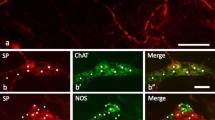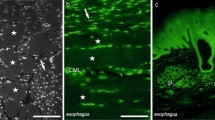Summary
A study was made of the innervation of the longitudinal muscle of the toad ileum with particular emphasis on the splanchnic innervation by non-adrenergic, noncholinergic (NANC) nerves.
Nerve fibres containing substance P-like immunoreactivity (SP-LI) were observed in the gut wall and in the splanchnic nerves. Virtually no SP-LI fibres survived in the ileal wall after degenerative section of the splanchnic nerves. Incubation overnight in a high concentration of capsaicin (3×10−4 M) caused degeneration of SP-LI fibres. No evidence was obtained for enteric neurons containing SP-LI.
Substance P caused a contraction of the longitudinal muscle similar to that produced by nerve stimulation. The response to nerve stimulation was decreased by about 60% by treatment with α-chymotrypsin. Capsaicin normally evoked a contraction of the longitudinal muscle, but did not do so after degenerative section of the splanchnic nerves. Prolonged treatments with high concentrations of capsaicin (5×10−5 M) abolished the excitatory response to nerve stimulation. The results suggest that substance P is the transmitter mediating the NANC contraction. The fibres releasing the transmitter are possibly antidromically activated, sensory afferents.
Both transmural stimulation and capsaicin caused a NANC inhibition of longitudinal muscle. Stimulation of perivascular nerves after splanchnic nerve section caused a NANC excitation, as did transmural stimulation even after nerve section or capsaicin treatment.
Similar content being viewed by others
References
Angel F, Go VLW, Szurszewski JH (1984) Innervation of the muscularis mucosae of the canine proximal colon. J Physiol (Lond) 357:93–108
Barthó L, Holzer P, Lembeck F, Szolcsányi J (1982) Evidence that the contractile response of the guinea-pig ileum to capsaicin is due to release of substance P. J Physiol (Lond) 332:157–167
Barthó L, Szolcsányi J (1978) The site of action of capsaicin on the guinea-pig isolated ileum. Naunyn-Schmiedeberg's Arch Pharmacol 305:75–81
Bishop, GH, O'Leary J (1938) Pathways through the sympathetic nervous system in the bullfrog. J Neurophysiol 1:442–454
Björkroth U (1983) Inhibition of smooth muscle contractions induced by a substance P antagonist. Acta Physiol Scand Suppl 515:11–16
Bowers CW (1985) A cadmium-sensitive, tetrodotoxin-resistant sodium channel in bullfrog autonomic axons. Brain Res 340:143–147
Bynke, G, Wahlestedt C, Beding B, Hakanson R (1985) Pupillary supersensitivity to substance P following prolonged treatment with tetrodotoxin or substance P antagonists. Eur J Pharmacol 108:217–223
Carter RH (1969) Resistance to tetrodotoxin in toad sympathetic nerves. J Pharm Pharmacol 21:395–396
Chahl LA (1982) Evidence that the contractile response of the guinea-pig ileum to capsaicin is due to the release of substance P. Naunyn-Schmiedeberg's Arch Pharmacol 319:212–213
Costa M, Buffa R, Furness JB, Solcia EL (1980a) Immunohistochemical localization of polypeptides in peripheral autonomic nerves using whole mount preparations. Histochemistry 65:157–165
Costa, M, Cuello AC, Furness JB, Franco R (1980b) Distribution of enteric neurones showing immunoreactivity for substance P in the guinea-pig ileum. Neuroscience 5:323–331
Costa M, Furness, JB, Llewellyn-Smith IJ, Cuello AC (1981) Projections of substance P-containing neurons within the guinea-pig small intestine. Neuroscience 6:411–424
Dalsgaard C-J, Hökfelt T, Schultzberg M, Lundberg JM, Terenius L, Dockray GJ, Goldstein M (1983) Origin of peptidecontaining fibers in the inferior mesenteric ganglion of the guinea-pig: immunohistochemical studies with antisera to substance P, enkephalin, vasoactive intestinal polypeptide, cholecystokinin and bombesin. Neuroscience 9:191–211
Duxson MJ, Campbell G (1986) Extrinsic sources of the innervation of duodenal longitudinal muscle in the toad Bufo marinus. J Auton Nervous Syst, submitted
Ekström J, Wahlstedt C (1982) Supersensitivity to substance P and physalaemin in rat salivary glands after denervation or decentralization. Acta Physiol Scand 115:437–446
Fitzgerald M (1983) Capsaicin and sensory neurons—a review. Pain 15:109–130
Franco R, Costa M, Furness JB (1979) Evidence that axons containing substance P in the guinea-pig ileum are of intrinsic origin. Naunyn-Schmiedeberg's Arch Pharmacol 307:57–63
Huidobro-Toro JP, Chelala CA, Bahouth S, Nodar R, Musacchio JM (1982) Fading and tachyphylaxis to the contractile effects of substance P in the guinea-pig ileum. Eur J Pharmacol 81:21–34
Iversen LL, Hanley MR, Sandeberg BEB, Lee C-M, Pinnock RD, Watson SP (1982) Substance P receptors in the nervous system and possible receptor subtypes. In: Porter R, O'Connor M (eds) Substance P in the nervous system. CIBA foundation symposium 91. Pitman, London, pp 186–205
Jessen KR, Polak JM, Van Noorden S, Bloom SR, Burnstock G (1980) Peptide-containing neurones connect the two ganglionated plexuses of the enteric nervous system. Nature 283:391–393
Kao CY (1966) Tetrodotoxin, saxitoxin and their significance in the study of excitation phenomena. Pharmacol Rev 18:997–1049
Maggi CA, Santicioli P, Manzini S, Meli A (1986) Capsaicin activates neurogenic non-adrenergic non-cholinergic relaxations of the isolated rat duodenum. Eur J Pharmacol 120:367–370
Morita K, North TA, Katayama Y (1980) Evidence that substance P is a neurotransmitter in the myenteric plexus. Nature 287:151–152
Morris JL, Gibbins IL, Campbell G, Murphy R, Furness JB, Costa M (1986) Innervation of the large arteries and heart of the toad (Bufo marinus) by adrenergic and peptide containing nerves. Cell Tissue Res 243:171–184
Papka RE, Furness JB, Della NG, Murphy R, Costa M (1984) Time course of effect of capsaicin on ultrastructure and histochemistry of substance P-immunoreactive nerves associated with the cardiovascular system of the guinea-pig. Neuroscience 12:1277–1292
Piercey MF, Dobry PJK, Einspahr FJ, Schroeder LA, Masiques N (1982) Use of substance P fragments to differentiate substance P receptors of different tissues. Regulatory Peptides 3:337–349
Rosell S, Björkroth U, Xu J, Folkers K (1983) The pharmacological profile of a substance P (SP) antagonist: evidence for the existence of subpopulations of SP receptors. Acta Physiol Scand 117:445–449
Russell LC, Burchiel KJ (1984) Neurophysiological effects of capsaicin. Brain Res Rev 8:165–176
Sneddon, JD, Smythe A, Satchell D, Burnstock G (1973) An investigation of the identity of the transmitter released by noncholinergic, non-adrenergic, excitatory nerves supplying the small intestine of some lower vertebrates. Comp Gen Pharmacol 4:53–60
Steinach E, Weiner H (1895) Motorische Functionen hinterer Spinalnervenwurzeln. Pflügers Arch 60:593–622
Szolsányi J, Barthó L (1978) New type of nerve mediated cholinergic contraction of the guinea-pig small intestine and its selective blockade by capsaicin. Naunyn-Schmiedeberg's Arch Pharmacol 305:83–90
Szolcsányi J, Jancsó-Gábor A, Joó F (1975) Functional and fine structural characteristics of the sensory neuron blocking effect of capsaicin. Naunyn-Schmiedeberg's Arch Pharmacol 287:157–169
Zernig G, Holzer P, Lembeck F (1984) A study of the mode and site of action of capsaicin in the guinea-pig heart and rat uterus. Naunyn-Schmiedeberg's Arch Pharmacol 326:58–63
Author information
Authors and Affiliations
Rights and permissions
About this article
Cite this article
Osborne, P., Campbell, G. A pharmacological and immunohistochemical study of the splanchnic innervation of ileal longitudinal muscle in the toad Bufo marinus . Naunyn-Schmiedeberg's Arch. Pharmacol. 334, 210–217 (1986). https://doi.org/10.1007/BF00505824
Received:
Accepted:
Issue Date:
DOI: https://doi.org/10.1007/BF00505824




